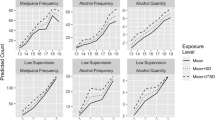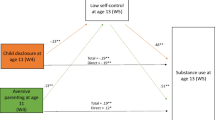Abstract
The nature and relative importance of psychosocial influences on smoking initiation among early adolescents are topics of substantial research interest. Students (N = 1081) from four middle schools were surveyed at the beginning and end of the sixth grade. Baseline predictors were regressed on smoking initiation at end of sixth grade. In bivariate, logistic regression analyses association with problem behaving peers, perceived prevalence, and depression were positively associated and adjustment to school, perceived social competence, parent expectations, parental monitoring, and parental involvement were negatively associated with smoking initiation. In multivariate logistic regression analyses controlling for sex, race, and school, peer affiliation and perceived prevalence were positively associated, whereas social competence and parental monitoring were negatively associated with smoking initiation. A significant interaction between parental involvement and peer affiliation indicated that among teens with problem behaving friends only those with parents who were relatively uninvolved were are at increased risk for smoking initiation. This finding held for boys, girls, Whites, Blacks, and teens living in single parent families. These findings provide evidence that antecedent parenting behaviors may protect early adolescents against smoking even in the context of negative peer affiliation.
Similar content being viewed by others
REFERENCES
Ajzen, I., & Fishbein, M. (1973). Attitudinal and normative variables as predictors of specific behaviors. Personality and Social Psychology, 27, 41–57.
Bandura, A. (1986). Social foundations of thought and action: A social cognitive theory. Englewood Cliffs, NJ: Prentice-Hall.
Baumrind, D. (1991). Effective parenting during the early adolescent transition. In P. A. Cowan, & E. M. Hetherington (Eds.), Family transitions. Advances in family research Series (pp. 111–163). Hillsdale, NJ: Erlbaum.
Caplan, M., Weissberg, R. P., Grober, J. S., Sivo, P. J., Grady, K., & Jacoby,C. (1992). Social competence promotion with inner-city and suburban young adolescents: Effects on social adjustment and alcohol use. Journal of Consulting and Clinical Psychology, 60, 56–63.
Chassin, L., Presson, C. C., & Sherman, S. J. (1990). Social psychological contributions to the understanding and prevention of adolescent cigarette smoking. Personality and Social Psychology Bulletin, 16, 133–135.
Chassin, L., Pillow, D. R., Curran, P. J., Molina, B. S., & Barrera, M. (1993). Relation of parental alcoholism to early adolescent substance use: A test of three mediating mechanisms. Journal of Abnormal Psychology, 102(1), 3–19.
Chassin, L., Presson, C. C., Rose, J. S., & Sherman, S. J. (1996). The natural history of cigarette smoking from adolescence to adulthood: Demographic predictors of continuity and change. Health Psychology, 15, 478–484.
Chilcoate, H. D., & Anthony, J. C. (1996). Impact of parent monitoring on initiation of drug use through late childhood. Journal of the American Academy Child and Adolescent Psychology, 35, 91–100.
Conrad, K. M., Flay, B. R., & Hill, D. (1992). Why children start smoking cigarettes: Predictors of onset. British Journal of Addiction, 87, 1711–1724.
Darling, N., & Steinberg, L. (1993). Parenting style as context: An integrative model. Psychological Bulletin, 113, 487–496.
DiClemente, R. J., Wingood, G. M., Crosby, R., Sionean, C., Cobb, B. K., Harrington, K., Davies, S., Hook, E.W., III, & Oh, M. K. (2001). Parental monitoring: Association with Adolescent risk behaviors. Pediatrics, 107(2), 1363–1368.
Dielman, T. E., Butchart, A. T., & Shope, J. T. (1993). Structural equation model tests of patterns of family interaction, peer alcohol use, and intrapersonal predictors of adolescent alcohol use and misuse. Journal of Drug Education, 23(3), 273–316.
Dishion, T. J., Capaldi, D., Spracklen, K. M., & Li, F. (1995). Peer ecology of male adolescent drug use. Development and Psychopathology, 7, 803–824.
Dishion, T., Capaldi, D., & Yoerger, K. (1999). Middle childhood antecedents to progressions in male adolescent substance use: An ecological analysis of risk and protection. Journal of Adolescent Research, 14(2), 175–205.
Dolcini, M. M., & Adler, N. E. (1994). Perceived competencies, peer group affiliation, and risk behavior among early adolescents. Health Psychology, 13(6), 496–506.
Dolcini, M. M., Adler, N. E., & Ginsberg, D. (1996). Factors in-fluencing agreement between self-reports and biological measures of smoking among adolescents. Journal of Research on Adolescence, 6(4), 515–542.
Epstein, J. A., Griffin, K. W., & Botvin, G. J. (2000). A model of smoking among inner-city adolescents: The role of personal competence and perceived social benefits of smoking. Preventive Medicine, 31, 107–114.
Everett, S. A., Warren, C. W., Sharp, D., Kann, L., Husten, C. G., & Crouter, A. C. (1999). Initiation of cigarette smoking and subsequent smoking behavior among U.S. high school students. Preventive Medicine, 29, 327–333.
Flay, B. R., Hu, F. B., Siddiqui, O., Day, L. E., Hedeker,D., Petraitis, J., Richardson, J., & Sussman, S. (1994). Differential influence of parental smoking and friends; smoking on adolescent initation and escalation of smoking. Journal of Health and Social Behavior, 35, 248–265.
Gilpin, E. A., Choi, W. S., Berry, C., & Pierce, J. P. (1999). How many adolescents start smoking each day in the United States? Journal of Adolescent Health 25, 248–255.
Hansen, W. B., & Graham, J. W. (1991). Preventing alcohol, marijuana, and cigarette use among adolescents: Peer pressure resistance training versus establishing conservative norms. Preventive Medicine, 20, 414–430.
Hansen W. B. (1992). School-based substance abuse prevention: A review of the state of the art in curriculum, 1980-1990. Health Education Research, 7, 403–430.
Harter, S. (1982). The perceived competence scale for children. Child Development, 53, 87–97.
Hetherington, E. M., Clingempee, I. L., Glenn, W., Anderson, E. R., Deal, J. E., Stanley-Hagan, M., Hollier, E. A., & Linder, M. S. (1992). Coping with marital transition. Monographs of the Society for Research in Child Development, 57, 2–3.
Jackson, C., Bee-Gates, D. J., & Henriksen, L. (1994). Authoritative parenting, child competencies, and intiation of cigarette smoking. Health Education Quarterly, 21(4), 103–116.
Jaccard, J., Turrisi, R., & Wan, C. K. (1990). Interaction effects in multiple regression. Beverly Hills, CA: Sage.
Jessor, R., & Jessor, S. (1977). Problem behavior and psychological development: A longitudinal study of youth. New York: Academic Press.
Johnston, L. D., O'Malley, P. M., & Bachman, J. G. (1996). National survey results on drug use from the monitoring and future study, 1975-1995. Vol. 1. Secondary school students. (DHHS Publication No. (NIH, NIDA) 96-4139). Washington, DC: U.S. Government Printing Office.
Lifrak, P. D., McKay, J. R., Rostain, A., Alterman, A. I., & O'Brien, C. P. (1997). Relationship of perceived competencis, perceived social support, and gender to substance use in young adolescents. Journal of the American Academy of Child and Adolescent Psychiatry, 36(7), 933–940.
McGinnis, J. M., & Foege, W. H. (1993). Actual causes of death in the United States. JAMA, 270(18), 2207–2212.
Patterson, G. R., Reid, J. B., & Dishion, T. J. (1992). Antisocial Boys. Eugene, OR: Castalia.
Patton, C. G., Carlin, J. B., Coffey, C., Wolfe, R., Hibbert, M., & Bowes,G. (1998). Depression, anxiety, and smoking initiation: A prospective study over 3 year. American Journal of Public Health, 88, 1518–1522.
Simons-Morton, B. G., Crump, A. D., Haynie, D. L., Saylor, K. E., Eitel, P., & Yu, K. (1999). Psychosocial, school, and parent factors associated with recent smoking among early adolescent boys and girls. Preventive Medicine, 28, 138–148.
Smith, G. T., & Goldman, M. S. (1994). Alcohol expectancy theory and the identification of high-risk adolescents. Journal of Research on Adolescence, 4(2), 229–247.
Stacy, A. W., Sussman, S., Dent, C. W., Burton, D., & Flay, B. R. (1993). Moderators of peer social influence in adolescent smoking. Personality and Social Psychology, 8(2), 163–172.
Steinberg, L., Fletcher, A., & Darling, N. (1994). Parental monitoring and peer influences on adolescent substance use.Pediatrics, 93(6), 1060–1064.
Sussman, S., Hahn, G., Dent, C. W., Stacy, A. W., Burton, D., & Flay, B. R. (1993). Naturalistic observation of adolescent tobacco Use. The International Journal of Addiction, 28(9), 803–811.
Weinberger, D. A. (1997). Distress and self-restraint as measures of adjustment across the life span: Confirmatory factor analysis in clinical and non-clinical samples. Psychological Assessment, 9(2), 132–135.
Author information
Authors and Affiliations
Rights and permissions
About this article
Cite this article
Simons-Morton, B.G. Prospective Analysis of Peer and Parent Influences on Smoking Initiation Among Early Adolescents. Prev Sci 3, 275–283 (2002). https://doi.org/10.1023/A:1020876625045
Issue Date:
DOI: https://doi.org/10.1023/A:1020876625045




